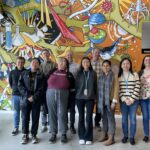Four undergraduate students from Arizona State University (ASU), all of Native American heritage, participated in an eight-week summer internship at Berkeley Lab as part of the ASU-Berkeley Lab STEM Pathways program.
iCLEM Summer Science Program’s Recipe for Success
The Introductory College Level Experience in Microbiology (iCLEM) summer intensive, hosted and run by the Joint BioEnergy Institute (JBEI) in Emeryville, immerses Bay Area high school students in the biological sciences through a curriculum of instruction, hands-on basic laboratory skill training, and tours of working labs within JBEI and local biotech companies. Since the program first launched in 2008, 95% of participants have gone on to continue their education at two or four-year colleges and universities, with 80% majoring in science or engineering. Given that the program specifically recruits teens who face socioeconomic hurdles to higher education, this impressive attendance rate is a point of pride among the scientists and educators who make iCLEM happen. Hoping to spread their prodigiously successful model beyond the confines of JBEI, a group of former and current scientific advisors have shared the iCLEM curriculum in the Journal of Microbiology & Biology Education.
Read more in the Berkeley Lab News Center.
A Winning Year for Biotech Partners Interns in the Biosciences Area
The Biosciences Area once again teamed up with Biotech Partners to provide paid summer internships to high school students. The mission of the non-profit is to provide underserved youth in the Bay Area with personal, academic, and professional development experiences that increase participation in higher education and access to fulfilling science careers. This year, seven high school students worked alongside Biosciences researchers across the Area’s laboratories.
On Saturday, August 10, the Biotech Partners interns presented their posters at BRAVO!, the end of summer celebration and poster competition. Three Biosciences interns—Ysabel David, Annie Lei, and Enzo Osorio—made it to the final round of the poster competition. Ysabel, who interned in the Celniker Laboratory, won the Best Overall Category for her poster on spatial gene expression in Drosophila melanogaster.
Mary Maxon Tells Leaders Carbon Could Be California’s Next Gold Rush
Biosciences ALD Mary Maxon recently spoke at an event hosted by the East Bay Economic Development Alliance about the East Bay’s unique biotech innovation ecosystem. During the panel discussion, Maxon noted that carbon waste could be California’s next gold rush, driving the bioeconomy. The discussion was recorded by Contra Costa TV and will be rebroadcast throughout October. Go here to see the schedule. Read more about this event at the “Tim Talk” blog on PleasantonWeekly.com.
Purdue Students Tour ALS
Corie Ralston, head of the Berkeley Center for Structural Biology and deputy director of the Molecular Biophysics and Integrated Bioimaging (MBIB) Division, and Mike Martin, Photon Science Operations Group Lead at the Advanced Light Source (ALS), led a tour of the ALS for a group of visiting biomedical engineering graduate students from Purdue University. Tammy Siemers, professional development and external relations specialist at Purdue University, arranges yearly ‘career immersion’ tours of companies and other places where graduate students might end up working one day. “The reason I chose ALS (and Lawrence Berkeley National Laboratory in general) is that I knew they were doing research in areas that our students would be interested in,“ said Siemers. “We had a great visit to ALS.”
The tours–which have taken place in Washington, DC, Boston, and Seattle previously–are important for the students to meet scientists and learn more about their options after graduate school. “I also like for students to gain networking skills and to learn about valuable resources and potential collaborations on this tour,” Siemers added. “ALS definitely has some valuable resources for research that we weren’t even aware of prior to this trip.”
- 1
- 2
- 3
- …
- 5
- Next Page »
Was this page useful?








